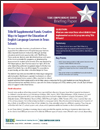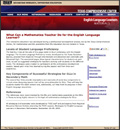SEDL's Free Briefs and Reports for English Language Learners
English Language Learners
Briefs and Reports
SEDL Insights, Vol. 1, No. 4: Teaching Mathematics Conceptually (2014)
Mathematics instruction in the United States has historically focused on procedures, facts, and algorithms. Because of that focus, mathematics instruction, in essence, becomes lessons in arithmetic and efficiency. While there are promising changes occurring in mathematics instruction, we still need to help both teachers and students develop a more conceptual understanding of mathematics. This issue of SEDL Insights helps educators shift from helping students memorize rules to facilitating a deeper understanding of mathematics concepts.
Research-Based Strategies for Teaching Social Studies, Science, and Mathematics to ELs at the Secondary Level: Texas Comprehensive Center Briefing Paper, Number 9 (2012)
This article provides useful research-based information for educators and others seeking to support English learners (ELs) at the secondary level in social studies, science, and mathematics. The article may also prove helpful for those who would like to learn about factors that influence the educational achievement of this significant and growing number of students. Furthermore, the authors provide some general strategies used in English as a Second Language (ESL) programs to demonstrate the distinction between ESL and the content needs of ELs.
This article provides useful research-based information for educators and others seeking to support English learners (ELs) at the secondary level in social studies, science, and mathematics. The article may also prove helpful for those who would like to learn about factors that influence the educational achievement of this significant and growing number of students. Furthermore, the authors provide some general strategies used in English as a Second Language (ESL) programs to demonstrate the distinction between ESL and the content needs of ELs.
Title III Supplemental Funds: Creative Ways to Support the Education of English Language Learners in Texas Schools: Texas Comprehensive Center Briefing Paper, Number 4 (2010)
This report describes how two school districts in Texas supported the achievement of English language learners (ELLs) beyond classroom instruction, through ancillary education enrichment opportunities with Title III funds. These particular districts were identified as those with some of the most successful ELL programs, as determined by improvement in student achievement.
This report describes how two school districts in Texas supported the achievement of English language learners (ELLs) beyond classroom instruction, through ancillary education enrichment opportunities with Title III funds. These particular districts were identified as those with some of the most successful ELL programs, as determined by improvement in student achievement.
What Can a Mathematics Teacher Do for the English Language Learner? (2009)
Based on a 2006 professional development session for math and ESL specialists, this online interactive document includes teaching strategies for ELLs at various levels, critical components to include when designing math lessons for ELLs, and a list of relevant resources.
Based on a 2006 professional development session for math and ESL specialists, this online interactive document includes teaching strategies for ELLs at various levels, critical components to include when designing math lessons for ELLs, and a list of relevant resources.




